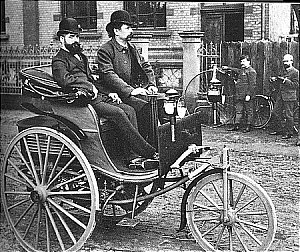
Circa 1887 |
(1) Early Motoring
Early motoring in Britain was not welcomed by the majority. It was available only to a wealthy elite whose often arrogant attitude led to resentment and fear, and regulation to control the speed and use of the motor car. Consequently, these early regulations caused British motoring and fuel distribution to develop much more slowly than in the USA. |
|
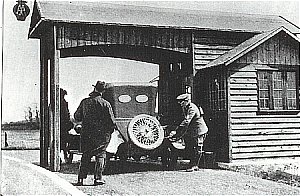
Circa 1920 |
(2) AA s first Roadside Filling Station in 1920
The UK industry was years behind America. Britain did not have its first filling station until the AA began a service to its members in 1919 at Aldermaston in Berkshire. |
 |
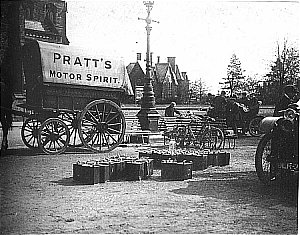
Circa 1908 |
(3) Two Gallon can delivery from Pratts
Petroleum spirit had to be collected from general stores, blacksmiths and chemists, and carried in cars by early motorists. Early bulk deliveries were made by rail and horse and cart! |
|
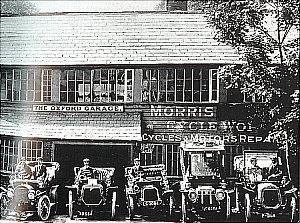
Circa 1925 |
(4) Early motoring
At last in the 1920s, motoring for the masses started to arrive. |
 |
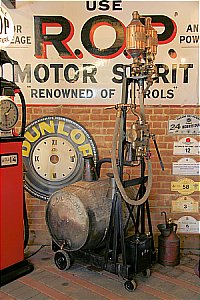
Circa 1904 |
(5) Victory Barrel Pump ROP Colours
Petroleum spirit, which was origionally used for lighting, was first distributed in 2 gallon cans and bulk barrels. As motor vehicles became more popular so the demand for petrol rapidly increased. Cans were both awkward and dangerous. Retailers and individual motorists wanted bulk storage and an easy, safe method of refilling their vehicles. |
|
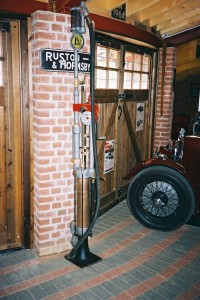
Circa 1910 |
(6) Early Gilbert and Barker Skeleton Pump
Underground steel tanks were popular both from safety and convenience considerations. The early pumps were purely functional in design - little more than a progression from a water pump. |
 |
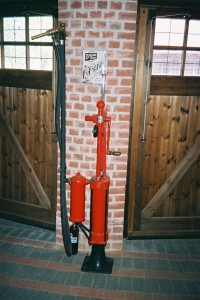
Circa 1915 |
(7) Early G/B Pump
Early "skeleton" pumps made refueling much safer, without the need to fill from cans via a funnel into hot motor vehicles (probably whilst the owner sat smoking his cigar)!! |
|
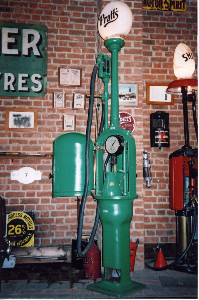
Circa 1915 |
(8) Gilbert and Barker Model T 8 Pump in Pratts Colours
Skeleton pumps soon became beacons to passing motorists to indicate the availability of petroleum spirit. Pumps were often over 8 feet (2.4 metres)tall with glass cylinders topped with illuminated glass globes. |
 |
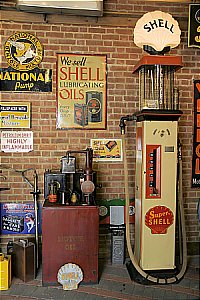
Circa 1920 |
(9) Visible Pump ( Australian) Old Shell Colours
Early petrol pumps were made using cast iron, brass, copper and glass. Surrounding these pumps were brightly coloured enamel signs advertising the multiple brands of petrol and oil sold, along with other services offered. |
|
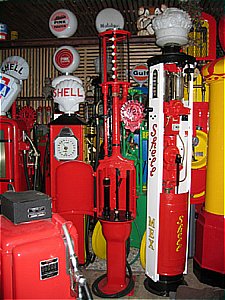
Circa 1930`s |
(10) Brightly painted early pumps.
It was the retailers objective to stand out and be recognised, which must have been quite a sight in a comparatively dull enviroment of the 1920s and 30s. |
 |
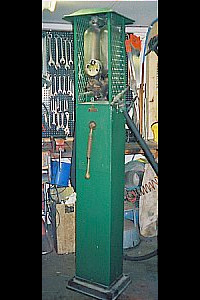
Circa 30's |
(11) Early Hammond Twin Gallon Pump.
Certainly, some local councils noticed and objected when things got out of hand, sometimes even forcing operators to remove signs and paint pumps a dull green. |
|
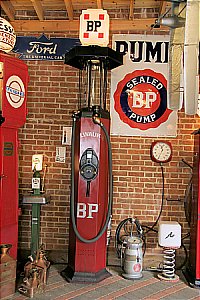
Circa 1926 |
(12) Early Milwalkee Visible Pump
With more cars came more interesting petrol pumps. These were initially often imported from America or manufactured under license. |
 |
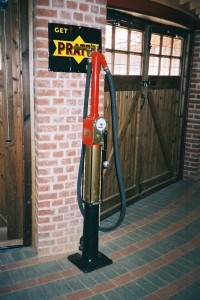
Circa 1920 |
(13) Avery Hardol Pumps
British engineering companys were soon manufacturing their own basic designs. |
|
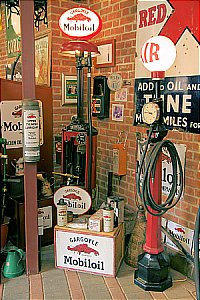
Circa 1925 |
(14) Browser Red Sentry Pump
Pumps soon increased in speed, and were fitted with gallon counters to measure how much fuel was delivered. |
 |
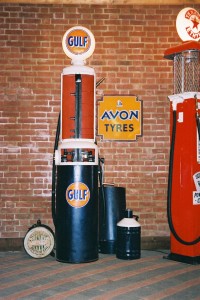
Circa 1922 |
(15) Gilbert Barker Pump. ( Gulf Colours)
Motorists tended to distrust these pumps however, as unlike the measured can, they could no longer be sure how much fuel had actually been delivered. |
|
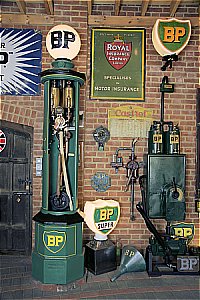
Circa 1925 |
(16) Britanic action twin 1 Gallon Pump - BP Colours
Hence the arrival of the next stage of pumps - the guaranteed measure cylinder pumps. |
 |
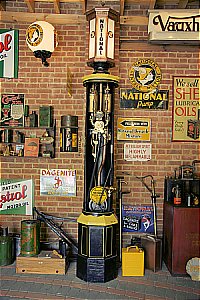
Circa 1925 |
(17) Britanic action twin Half Gallon Pump.
Instead of pumping directly into a vehicle, these pumps first pumped into a copper (gallon or half gallon)cylinder. When the cylinder was full the fuel could be seen overflowing back into the supply tank via the sight glass. |
|
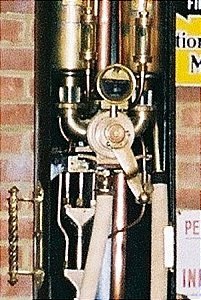
Circa 1925 |
(18) Cylinder switching gear for early Britanic Pumps
The value could then be switched in order to empty the fuel into the vehicle's tank, whilst a second copper measured cylinder was being fitted. |
 |
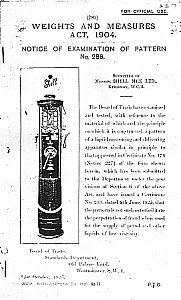
Circa 1925 |
(19) Courtesy of Noel Clarke
Pump designs had to be registered with weights and measures and issued with a pattern number. |
|
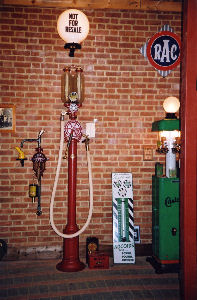
Circa 1925 |
(20) Hammond Twin 1 Gallon glass Cylinder Pump
Copper cylinders progressed to glass fronted visible measures. These cylinders soon became made of glass, such as this early Hammond (ex war dept) pump. |
 |
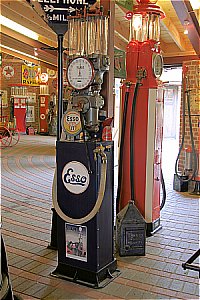
Circa 1928 |
(21) Siam French 5 Ltr Pump
Similarly in Europe, five litre glass cylinders enabled the fuel to be seen flowing and thus ensured a fair and visible measure. |
|
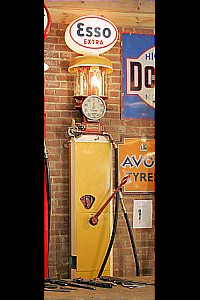
Circa 1930`s |
(22) Satam Wall Pump
Where space was limited, these wall pumps were created. This Satam pump was used in a narrow city street in Paris. |
 |
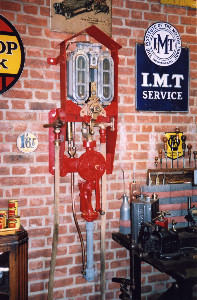
Circa 1925 |
(23) Britanic Red Wall Pump
Wall pumps were also used in England, such as this Britanic pump owned origionally by Shell. |
|
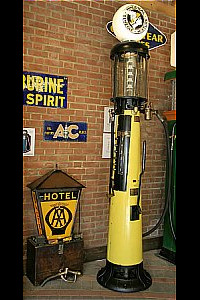
Circa 1930 |
(24) Wayne 5 gallon Visible pump
In time, five gallon cylinders were used for visible pumps, allowing for faster deliveries. This type of pump was either imported from America or made under licence, such as this one made for National Benzol. |
 |
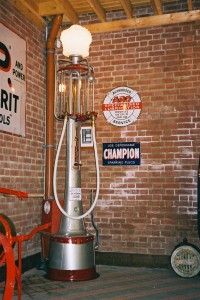
Circa 1927 |
(25) Fry Model 117 10 Gall Visible pump by Guaranteed Measure Co.
These American pumps were quite dramatic to see, with five gallons of fuel sat in a glas jar above a motorist's head, next to a steaming car! In the USA, ten gallon or even 15 gallon pumps were made. |
|
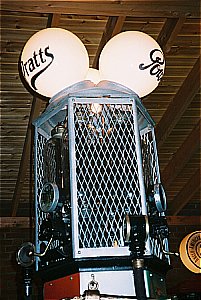
Circa 1933 |
(26) Hammond Triple Pump
In the UK, this rare triple pump was made with three globes, three pumps and six glass gallon cylinders, serving three different brands of fuel. |
 |
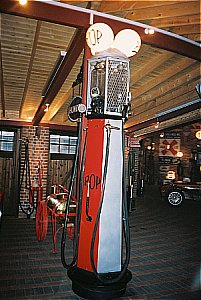
Circa 1933 |
(27) Hammond Triple Pump
It stands 10 feet (3 metres) tall, has a diameter of 2ft 6in (75cm) and is very heavy!! |
|
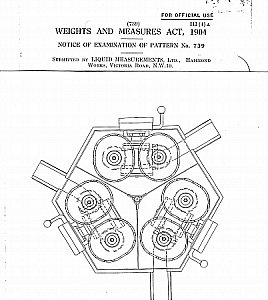
Circa 1933 |
(28) Top plan View of 6 Glass Cylinders of Hammond Triple Pump
The official Weights and Measures documents provide an invaluble source of information when restoring pre-war petrol pumps. The Act of 1904 required that all pumps were registered with a full operating description and drawings. |
 |
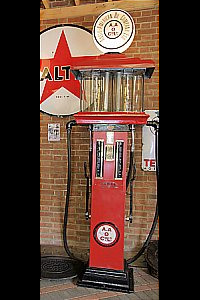
Circa 1938 |
(29) Erie Double 5 Gallon Visible Pump
Double visible pumps were made, such as this twin five gallon pump used in Australia, which enabled two cars to be served at the same time from one pump. |
|
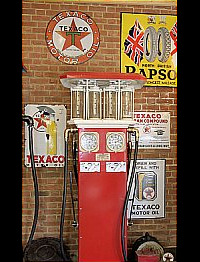
Circa 1937 |
(30) Texaco Double Pump with 4 x 1 Gall Cylinders
This double pump has four one gallon cylinders, and was used in Australia but made in Thailand for Texaco. |
 |
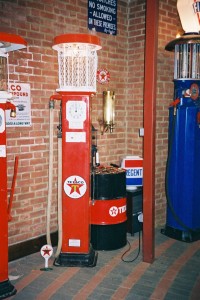
Circa 1937 |
(31) Matching Texaco Single Pump
This is the matching two gallon single pump. |
|
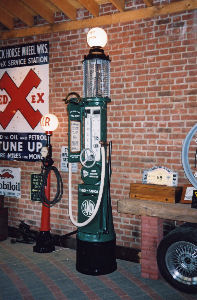
Circa 1930 |
(32) Early Theo Samoa Multiple Pump
Theo & Co in Liverpool developed fabulous "multiple" pumps, which could serve up to six different brands of fuel from one pump without contamination from mixed fuels. |
 |
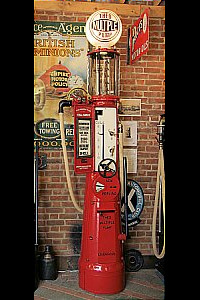
Circa 1930 |
(33) Theo Multiple Pump
These pumps were wonderfully engineered and are highly collectable today. (I believe they were also unique to the UK) |
|
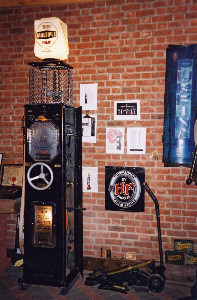
Circa 1936 |
(34) Theo Electric 6 Gall
Theo pumps in later years used an electric pump to remove the air from the glass cylinder and suck the fuel up. Once the cylinder was full to the desired level and running out the overflow, the vacuum was released by opening the "fill tank" lever. This allowed the surplus fuel in the pipework to drain back into the tank thus avoiding contamination if a different brand of fuel was selected by the next customer. |
 |
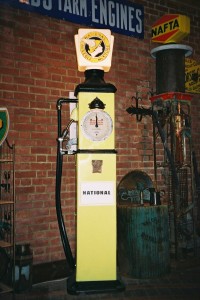
Circa 1934 |
(35) Bowser Electric Pump
All of these previously mentioned pumps were hand operated, but naturally the electric motor had to take over. |
|
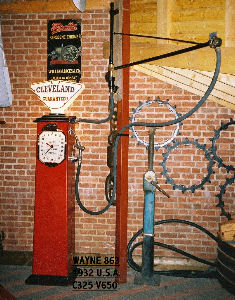
Circa 1932 |
(36) Wayne 863 Electric Computer pump.
A few pumps used the motor to fill a glass cylinder, but soon the more recently developed computer price pumps took over. |
 |
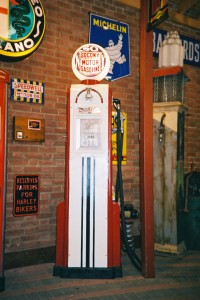
Circa 1936 |
(37) Wayne 60 Electric Pump
Early electric pumps were quite attractive, particularly the Art Deco styled pumps, such as this Wayne 60 model. |
|
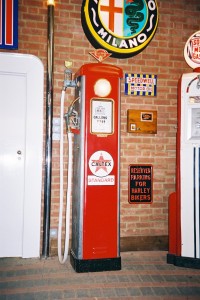
Circa 1938 |
(38) Wayne Early Electric Price Computer Pump
However, by the 1940s, new models became more and more similar and visually uninteresting. |
 |
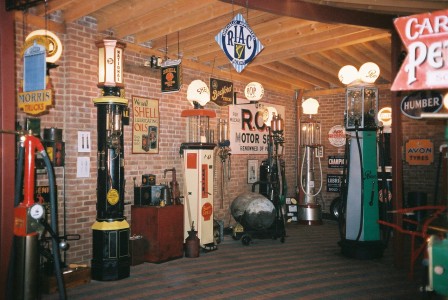
Circa Early 20Century pumps. |
(39) A corner of my garage.
My personal interest in pumps stops at around 1940, thus most of my collection represents a fairly concise 30 year period. |
|
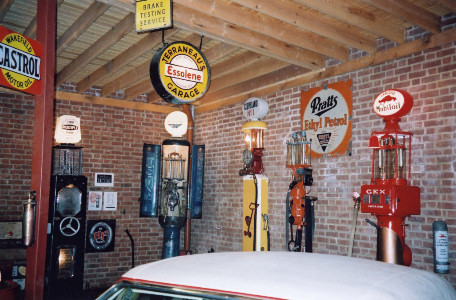
Circa 1930`s |
(40) A few French pumps.
This period created a diverse range of equipment for dispensing fuel. |
 |
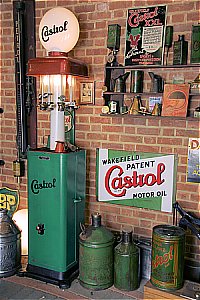
Circa 1932 |
(41) Bowser Oil Fountain
Early motor vehicles used much more oil than those of today. This superb rare Bowser oil fountain dispensed eight different oils with the cover sliding up to secure the unit at night. |
|
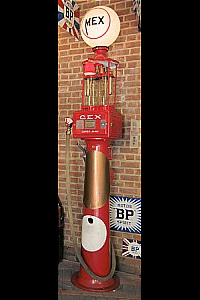
Circa 1933 |
(42) Gex Turn 5 litre Visible Pump
In addition to British pumps I have also collected and restored some wonderful pumps from Europe. The French pumps are superb. |
 |
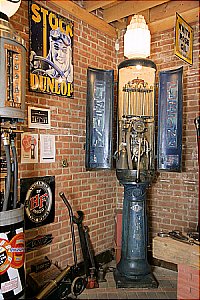
Circa 1925 |
(43) SIAM Two Door Visble Pump in Purfina Cols.
This French Siam twin five litre pump still has it's origional "Purfina" paintwork on the doors. Many variations of these pumps were made particularly in France but also in Germany and Italy. |
|
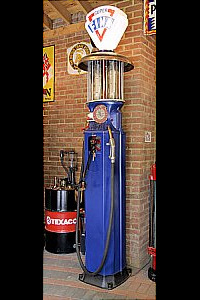
Circa 1933 |
(44) SATAM FINA Pump Blue
Another popular French pump from Satam. |
 |
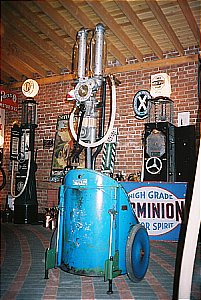
Circa 1930 |
(45) Satam Chariot Pump
These early barrel pumps offered another method of delivering fuel. |
|
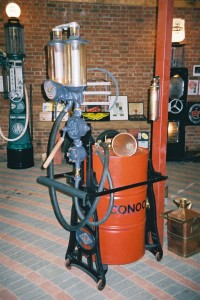
Circa 1930 |
(46) SIAM Barrel Pump ( Conoco)
|
 |
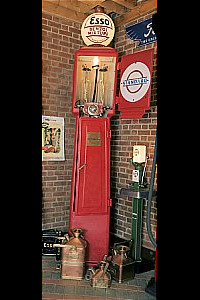
Circa 1934 |
(47) German
It is interesting to recognise the different national architectural designs used in early pumps from different countries. |
|
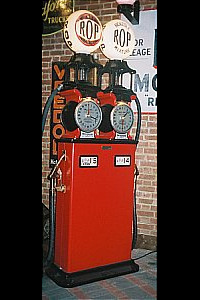
Circa 1930 |
(48) Wayne 803 Double
One of my favourite pumps is this Wayne 803 double which has two pumps and four faces. The restoration/recreation of this pump took several months with help from fellow collectors in Europe and America. |
 |
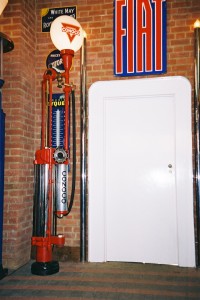
Circa 1930 |
(49) Early 10 Gall Canadian Skeleton Pump
This Canadian ten gallon skeleton pump may origionally have had sheet steel skins. Anyone know more? Part of the purpose of this website is to collate information. Please use the "contact" section to pass on any details and I will add relevant items. |
|
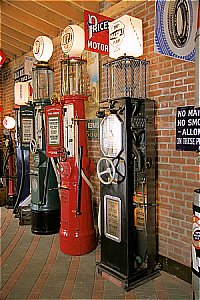
Circa 1930,s |
(50) Garage Int. Shot 2 x Theos /Satam / Siam
Theo & Co manufacturers based in Liverpool (UK) made these superb quality pumps capable of dispensing up to six diferrent brands of fuel. On the left is an early Theo Samoa and on the right is the later electric model from 1936. Both had cast iron bodies with complicated internal mechanisms. |
 |
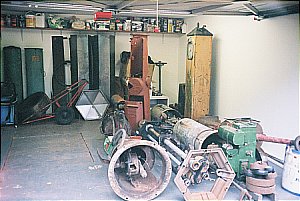
Circa 1930,s |
(51) Pumps awaiting restoration Theo/ Abbey/ Milwaukee
Unlike many interested in petroliana, my collection centres on petrol pumps. I actively hunt for different pumps, research them and restore them myself purely as a hobby. Nothing in my collection is for sale, but I am always happy to share information with anyone interested. If you happen to discover a pump for sale that is not represented in my collection please contact me. Most of my pumps are listed in the "galleries" (pumps) section of the website.
HOPE YOU ENJOY THE SITE!!!!! |
|

